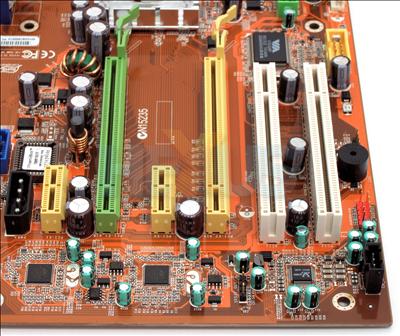Foxconn N570SM2AA layout and features
The layout of the N570SM2AA is good in most respects. There's plenty of room around the CPU socket area, which is helped by the lack of a discrete northbridge and Foxconn's decision to use digital PWM rather than traditional capacitors.
The 4-pin 12V power connector is in a sensible position and Foxconn has located one of the two SATA2 ports - run off the JMicron JMB363 ASIC - near the middle of the board. The ASIC itself is directly to the right of the blue-coloured port.
The board supports dual-channel DDR2 memory at speeds up to 800MHz. That's a potential 12.8GB/s on tap and plenty for AM2 processors to play with. It doesn't support LinkBoost Technology, as per the nForce 590 SLI chipset, but that doesn't offer a whole heap of extra performance when evaluated at default speeds.
The two PATA ports, both run off different controllers, are grouped at the edge of the board. It's sensible to locate floppy and the main 24-pin power connector with them, and that's exactly what Foxconn has done.
To the very left of the above picture is where Foxconn has situated its TigerOne ASIC that controls system monitor, overclocking and manual speed control. It has no board-mounted LEDs, however, and, as such, misses out on some much-needed functionality.
Moving on to the left, the nForce 570 SLI SPP is actively cooled by a noisy 40mm fan whose speed cannot be controlled from within the BIOS. The core logic's 6 SATA ports - the non-latching variety - are located nearby, sensibly, and headers for 6 USB2.0 ports are just to the right. FireWire400 support is directly behind, powered by the VIA VT6308P ASIC.
Slot arrangement is reasonably good. You will lose one PCIe x1 and one PCIc slot if double-width NVIDIA cards are installed for SLI usage, but that's the norm for most boards. Locating one PCIe x1 at the very top (left) means that system RAM can be installed and removed without having to fiddle with the main graphics card.
The edge of the board is lined with the two Marvell PHYs and Realtek ALC882H audio CODEC we spoke about on the previous page.
The I/O section contains a mixture of old and new. Parallel and PS/2 ports ensure legacy compatibility. Audio connectivity is well-represented with the usual speaker ports and both optical and coaxial S/PDIF-outputs.
Four of the board's ten USB2.0 ports are integrated in to the backplane and dual GigE is always nice. The remaining high-speed port, run off the JMB363 controller, is an eSATA connection that supports hot-plugging from external, compatible drives.














